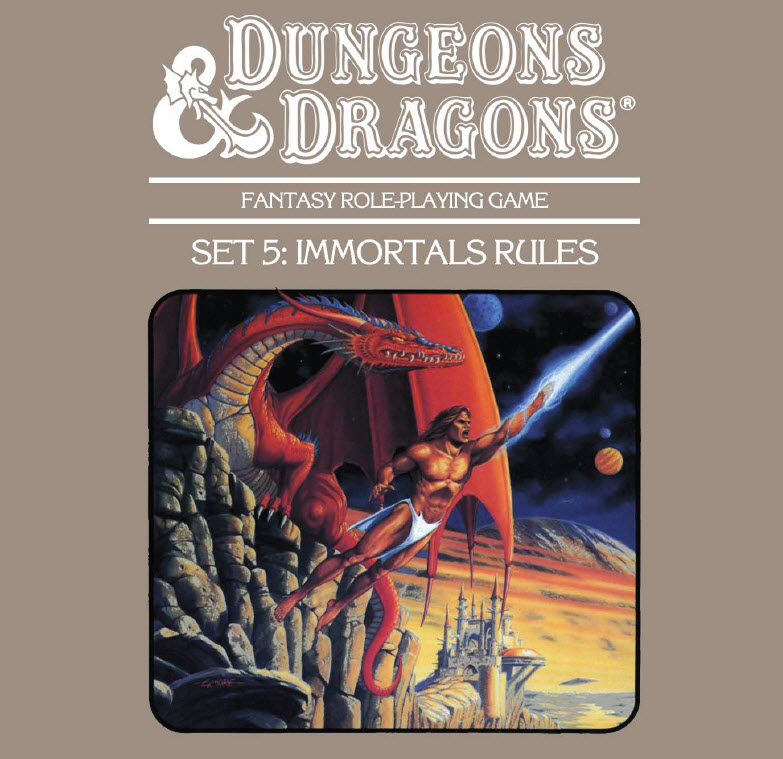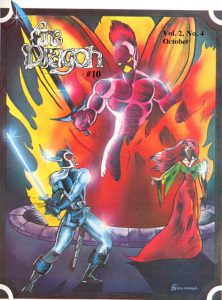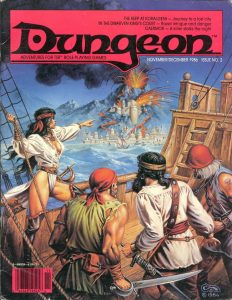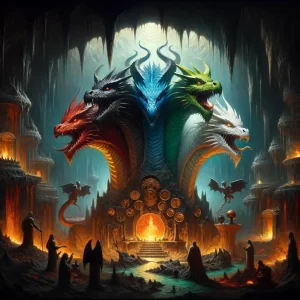
The Dungeons & Dragons Immortal Set (also known as Set 5: Immortals Rules) is the final chapter of the classic D&D Basic series, wrapping up the legendary BECMI (Basic, Expert, Companion, Master, and Immortal) line. Released in 1986, it provided rules for adventurers who had transcended the mortal limits of power and skill, elevating them to god-like status as Immortals. This box set, designed by the esteemed Frank Mentzer, allowed players to explore the realms beyond mortal understanding, offering them the chance to experience cosmic adventures, manage vast spheres of influence, and even shape the fabric of existence itself.
The Immortals Set marked a dramatic departure from the more traditional adventuring present in earlier sets. It offered a framework for playing characters who had ascended to near-divine status, introducing new rules for gameplay on a cosmic scale. Within this set, players could create and play as Immortals, exploring realms far beyond mere dungeons and dragons.
The box set was packed with the following essentials:
Players' Guide to Immortals: This guidebook gave players the tools to ascend their characters to Immortal status. It introduced the concept of "Spheres of Power" (Matter, Energy, Thought, Time, and Entropy) and the various powers and abilities that came with them.
Dungeon Master's Guide to Immortals: This guide provided Dungeon Masters (DMs) with extensive information on creating adventures and conflicts suitable for Immortal characters. It included mechanics for creating Immortal-level threats, managing grand-scale battles, and shaping the universe itself.
Game Rules and Mechanics: The set presented new rules for spellcasting, combat, and even cosmic events, which could alter entire worlds. Immortal characters no longer concerned themselves with mundane treasure or experience points but instead focused on gaining Power Points (PP) to wield their cosmic influence.
New Lore: The Immortals Set expanded the world of D&D with rich lore, detailing the various realms and dimensions Immortals could traverse and interact with. It laid the foundation for a multiverse teeming with worlds, populated by entities of god-like power, and touched on the responsibilities and dangers faced by those who dared to meddle in cosmic affairs.
The Spheres of Power
One of the defining features of the Immortals Set was the introduction of the "Spheres of Power." Upon ascending to Immortality, characters would align themselves with one of these spheres:
Matter - Representing physical reality and permanence.
Energy - The force of magic, life, and motion.
Thought - The sphere of consciousness, intellect, and spirit.
Time - Governing the passage of events and history.
Entropy - Associated with destruction, decay, and chaos.
Each sphere offered unique abilities and power sets, giving players a wide array of divine-like capabilities. Aligning with a sphere also shaped the Immortal's goals, actions, and even personality, making this choice crucial for character development.
Gameplay at a Cosmic Scale
The Immortals Set altered traditional gameplay to suit its divine protagonists. Here are some key aspects:
Power Points (PP): Instead of experience points, Immortals accrued Power Points, a measure of their cosmic influence. These points could be spent to perform miraculous feats, affect entire realms, or combat other Immortals.
Immortal Combat: Immortal-level combat involved a mix of physical might, magical power, and divine influence. Immortals could face off against other god-like beings, monstrous titans, or cosmic forces threatening entire worlds.
Creating and Shaping Realms: One of the most exciting aspects was the ability for Immortals to create and shape their own realms. The DM's Guide to Immortals included detailed rules for realm creation, allowing players to forge their divine sanctuaries and manage the balance of power within them.
Cosmic Politics: The Immortals Set delved into the politics of the divine, with Immortals engaging in alliances, betrayals, and wars that could reshape the cosmos. The sphere each Immortal belonged to often influenced these interactions, creating complex narratives of power and intrigue.
The Immortals Set was revolutionary in how it expanded the scope of D&D gameplay. It allowed players to experience adventures that went beyond the mortal realm, setting the stage for epic storylines and character arcs that transcended traditional dungeon-crawling. This cosmic perspective has since influenced subsequent editions of Dungeons & Dragons, particularly in how they handle god-like characters and epic-level play.
In many ways, the Immortals Set foreshadowed later developments in tabletop gaming and storytelling, where campaigns often explore themes of divinity, power, and the delicate balance between order and chaos. It introduced players to the concept that D&D wasn't just about looting dungeons or slaying dragons but could also explore more profound existential questions about creation, existence, and the cosmos.
Trivia and Fun Facts of Immortals Rules
- Origins of the Immortals Concept: Before the Immortals Set was published, early versions of D&D already hinted at the possibility of player characters becoming divine beings. The 1976 supplement Eldritch Wizardry introduced demon lords and demigods, setting the groundwork for the Immortals concept. The Immortals Set took these ideas to a whole new level.
- Frank Mentzer's Influence: Frank Mentzer, the designer of the BECMI series, sought to create a complete and satisfying progression system for characters, starting from zero-level nobodies in the Basic Set to cosmic deities in the Immortals Set. His vision transformed D&D, providing players with a full-fledged journey from mortals to gods.
- Advanced D&D Parallel: At the same time the BECMI series was unfolding, Advanced Dungeons & Dragons (AD&D) was on a separate path. The Immortals Set's themes and rules would later inspire some elements in AD&D, particularly in epic-level campaigns and the development of god-like NPCs.
- From Immortals to Wrath of the Immortals: In 1992, the Wrath of the Immortals box set was released, essentially revising and expanding upon the rules from the original Immortals Set. This updated version streamlined some of the more complex mechanics, focusing on epic storytelling and Immortal-level campaigns while retaining the grandeur of the original.
- Rules Complexity: The Immortals Set is known for its complexity. Transitioning from regular D&D play to Immortal-level gameplay required understanding new rules for Power Points, divine influence, and cosmic scale conflicts. Many groups used the set more as inspiration for narrative arcs than as a strict rulebook.
- An Unmatched Level of Play: Few D&D products have since revisited the sheer scale of the Immortals Set. While modern editions include epic-level play and gods, the idea of characters becoming full-fledged cosmic entities remains unique to this boxed set.
- Impact on the Multiverse: The Immortals Set laid some of the early groundwork for the concept of the D&D multiverse. By introducing multiple realms, dimensions, and spheres of power, it expanded the imaginative scope of the game universe, paving the way for the extensive lore present in later editions.
The Dungeons & Dragons Immortals Set is a testament to the imagination and ambition of early D&D design. By opening the door to cosmic adventures and divine power, it encouraged players and DMs alike to think beyond the confines of traditional fantasy. To this day, it remains a unique and cherished piece of D&D history, inspiring grand tales of immortality, divine conflict, and the ultimate quest for cosmic balance. Whether used as a rulebook or a source of inspiration, the Immortals Set continues to hold a place in the hearts of those who dream of adventures that reach beyond the stars.






